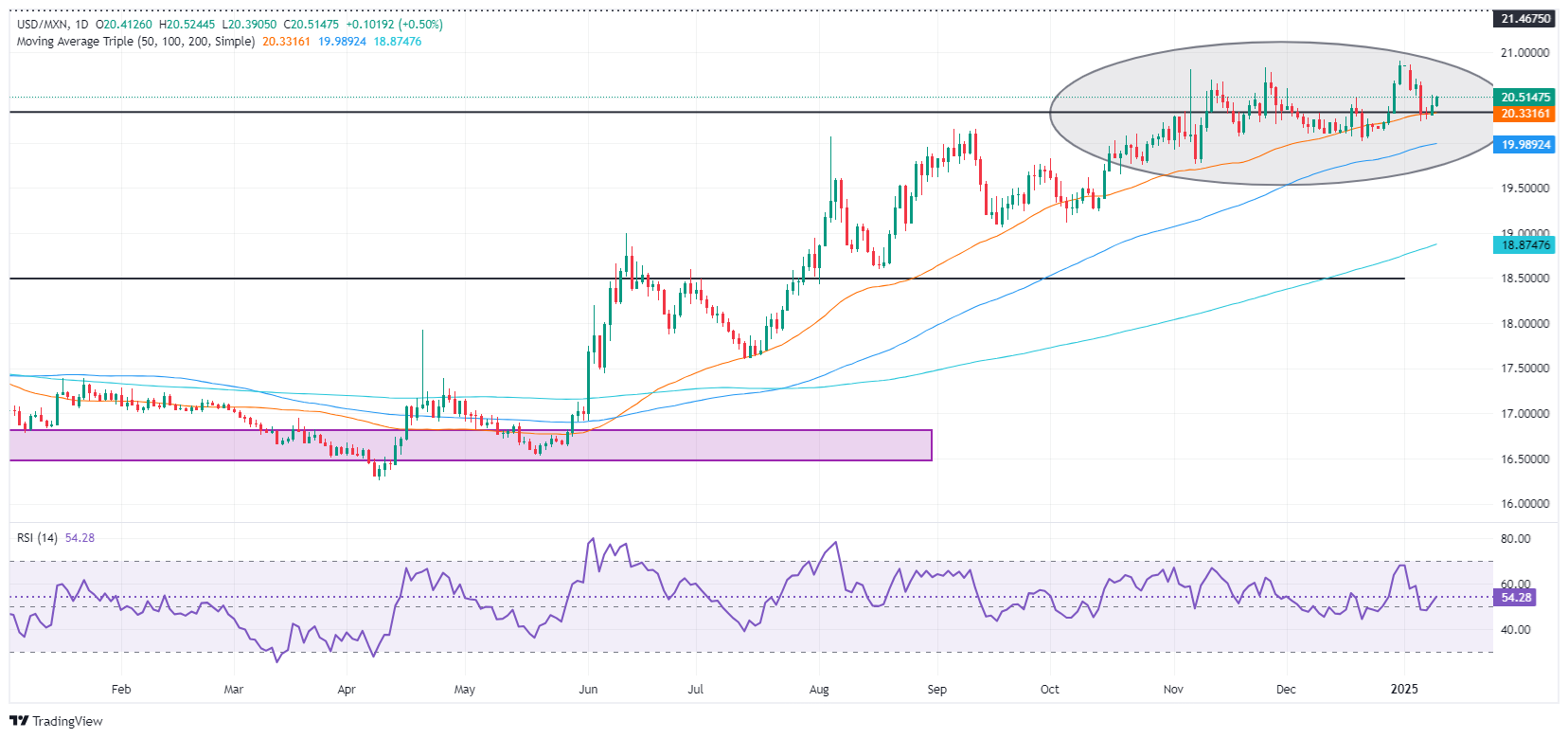- Mexican Peso faces strain after Banxico’s dovish shift suggests bigger, and presumably faster, rate of interest cuts.
- Combined inflation information from INEGI maintains uncertainty, including to Peso’s volatility in gentle buying and selling circumstances.
- Rate of interest differential considerations improve as Banxico’s potential 150 bps cuts distinction with the Fed’s extra conservative 57 bps easing outlook.
The Mexican Peso loses some floor in opposition to the US Greenback on Thursday after the Banco de Mexico (Banxico) hinted that rates of interest may very well be lowered sooner in some conferences. This and the disinflation progress weighed on the Peso regardless of skinny buying and selling in observance of the funeral of former US President Jimmy Carter. The USD/MXN trades at 20.50, up 0.55%.
The Instituto Nacional de Estadística Geografía e Informatica (INEGI) revealed that inflation figures have been blended. Nonetheless, Banxico turned dovish, whereas a member mentioned it was needed to extend the scale of the speed cuts.
Subsequently, the Peso could be susceptible to additional depreciation as a result of discount of the rate of interest differential between Mexico and the US. Though Federal Reserve (Fed) officers said they’re in an easing cycle, however market gamers are eyeing simply 57 foundation factors (bps) of easing within the US this yr in opposition to 150 bps by Banxico.
Day by day digest market movers: Mexican Peso weakened by dovish tone of Banxico minutes
- Banxico’s assembly minutes revealed the evolution of disinflation, suggesting that the easing cycle may proceed to scale back the restiveness of financial coverage. To realize that, the Governing board said, “bigger downward changes may very well be thought-about in some conferences.”
- Mexico’s central financial institution improved the inflation outlook as a result of progress in headline and core inflation. Officers acknowledged that providers inflation decreased, they usually anticipate CPI to converge to its 3% aim in Q3 2026.
- INEGI revealed that December’s Shopper Value Index (CPI) dipped to 0.38% MoM under estimates of 0.40% and the prior month’s 0.44% soar. Core CPI in the identical interval elevated by 0.51%, up from 0.05% within the prior studying and above the forecasted 0.45%.
- On an annual foundation, headline inflation got here in at 4.21%, lacking projections of 4.28% and was beneath November’s 4.55% studying. Excluding risky gadgets, inflation modestly elevated from 3.58% to three.65%, exceeding expectations of three.62%.
- On Wednesday, the Fed revealed its December Assembly Minutes. Officers opted to scale back borrowing prices by 25 foundation factors, however the minutes confirmed that “some contributors noticed advantage in sustaining charges at present ranges, citing the heightened threat of persistently excessive inflation.”
- Regardless of this, policymakers anticipated inflation to proceed shifting towards the US central financial institution’s 2% aim, though they acknowledged potential modifications in commerce and immigration coverage. A number of officers famous that the disinflationary course of “stalled.” The Minutes underscored that Fed officers opened the door to slowing the tempo of rate of interest cuts.
USD/MXN technical outlook: Mexican Peso stays heavy as USD/MXN climbs above 20.35
The USD/MXN uptrend stays intact. Throughout the week, sellers tried to push the trade fee under the 50-day Easy Shifting Common (SMA) of 20.29 however failed because the pair discovered acceptance close to the 20.40 to twenty.50 vary.
If consumers clear the top quality, the subsequent resistance could be final yr’s excessive of 20.83, adopted by the present yearly excessive of 20.90. On additional power, the USD/MXN might take a look at 21.00, forward of the March 8, 2022 excessive at 21.46.
Conversely, if USD/MXN tumbles under the 50-day SMA, the subsequent help could be the 20.00 determine, forward of the 100-day SMA at 19.93, adopted by the 19.50 determine.

Mexican Peso FAQs
The Mexican Peso (MXN) is essentially the most traded foreign money amongst its Latin American friends. Its worth is broadly decided by the efficiency of the Mexican financial system, the nation’s central financial institution’s coverage, the quantity of overseas funding within the nation and even the degrees of remittances despatched by Mexicans who stay overseas, notably in the US. Geopolitical tendencies may also transfer MXN: for instance, the method of nearshoring – or the choice by some corporations to relocate manufacturing capability and provide chains nearer to their house international locations – can be seen as a catalyst for the Mexican foreign money because the nation is taken into account a key manufacturing hub within the American continent. One other catalyst for MXN is Oil costs as Mexico is a key exporter of the commodity.
The principle goal of Mexico’s central financial institution, also called Banxico, is to keep up inflation at low and secure ranges (at or near its goal of three%, the midpoint in a tolerance band of between 2% and 4%). To this finish, the financial institution units an applicable stage of rates of interest. When inflation is simply too excessive, Banxico will try and tame it by elevating rates of interest, making it dearer for households and companies to borrow cash, thus cooling demand and the general financial system. Greater rates of interest are usually constructive for the Mexican Peso (MXN) as they result in larger yields, making the nation a extra engaging place for traders. Quite the opposite, decrease rates of interest are likely to weaken MXN.
Macroeconomic information releases are key to evaluate the state of the financial system and may have an effect on the Mexican Peso (MXN) valuation. A powerful Mexican financial system, based mostly on excessive financial development, low unemployment and excessive confidence is sweet for MXN. Not solely does it appeal to extra overseas funding however it might encourage the Financial institution of Mexico (Banxico) to extend rates of interest, notably if this power comes along with elevated inflation. Nonetheless, if financial information is weak, MXN is more likely to depreciate.
As an emerging-market foreign money, the Mexican Peso (MXN) tends to try throughout risk-on durations, or when traders understand that broader market dangers are low and thus are keen to have interaction with investments that carry the next threat. Conversely, MXN tends to weaken at occasions of market turbulence or financial uncertainty as traders are likely to promote higher-risk property and flee to the more-stable secure havens.
